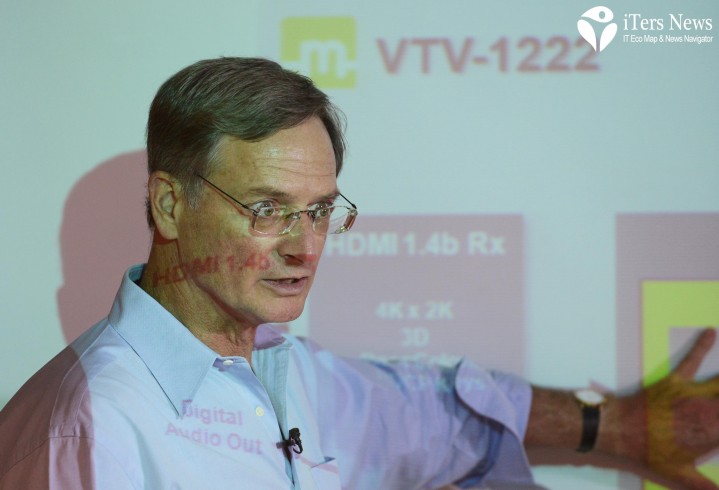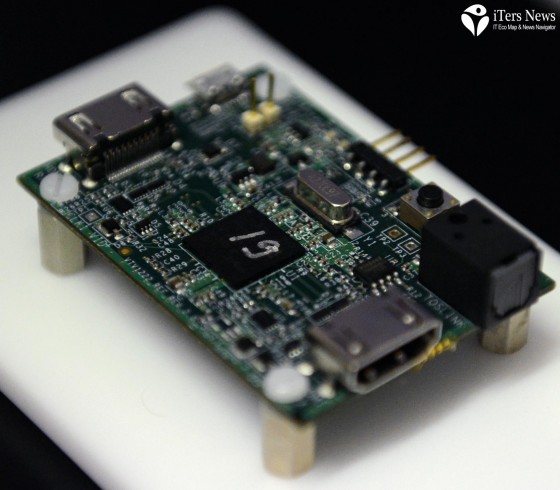(iTers News) – 4K display is what top-tier LCD TV makers across the world are making a hefty and high-stakes bet on, as it promises to revitalize years-long idle demand for LCD TVs, pumping up new excitements into the matured and marginally profitable market.
Yet, it will take a while before the 4K technology will have gone mainstream, as the TV industry still has a long way to go until it creates an entire 4K manufacturing ecosystem from a 4K video processor to an industry-wide 4K data compression technology standard to a real 4K LCD panel.
On-the-middle-of-the-road, however, Marseille Networks, Inc. is scrambling to speed up the penetration of 4K technology by enabling makers of source devices like Blu-Ray players and STBs as well as TV makers to get their product offering ready to deliver 4K image viewing experiences.
The Santa Clara, California-based chip maker is now globe-trotting across Asian countries to promote its VTV-1222 4K video pre-processor, a sort of 2K to 4K video converter chip that can scale up HD images to 4K resolutions.
“The 4K has four times as high resolution as HD 2K technology. HD is about 2 mega-pixels, while 4K is about 8 mega-pixels. To take the HD contents and scale up it to 4K, we have to create three pixels per every one that exists” said George Alexy, vice president in marketing with Marseille, Networks Inc.
“The art-form in the Intellectual Property, or IP of our company is the algorithm that we developed and validated on our virtualization technology to in fact provide the highest quality scaling from HD to 4K,” added he.
Take off to a fast start
His idea is to lay the groundwork for source device makers to lead the growth of 4K-ready markets and eventually real 4K display market in the same way that they spearheaded the spectacular spurt of the HD-ready markets between 2006 and 2008, providing a spring board for the real HD TV market to jump along later.
“HD was first introduced into the market around 1998. It took years before it took off as contents started to show up. But, once it started, the ramp-up was very rapid on what we called source devices. Blue Ray players, STBs and AVRs started to adopt HD very quickly to go from 480 to 480p to 720p and 1080p up-scaling capability to carry contents forward to more current higher technology display,” added he.
(George Alexy / Vice President, Marketing photographed by JH BAE)
According to him, the market penetration of HD 1080p picture images in source devices went up from 10% to 80% in the 2006 to 2008 time frame. Yet, sales of HD TV made up for just 25% of the total TV market in 2008.
He expects the same growth pattern to happen in the 4K display market.
“As 4K technology started to become more prevalent and be more understood, we anticipate 4K source device will be adopted very quickly, because prices of 4K-ready source devices are not expensive. So people will be buy 4K-ready source devices in anticipation of purchasing 4K TV display devices,“ said he.
To live up to the anticipation, Marseille taped out the VTV-1222 4K pre-processor chip on July 19 using Taiwanese foundry chip maker TSMC.
“As the history shows, we want to focus first on 4K source devices with a very-cost effective and easy-to-use and easy-to-deploy solution to enable the fast ramp-up, and capture the leading edge of transition of the source devices to 4K,” he explained.
Fabricated with TSMC’s 65nanometer design rule, the 4K processor chip integrates HDMI Rx & Tx interface, image enhancement blocks, 4K HD scaler, de–interlacer, and color formatting. It has also 1Mbit on-chip Nor flash for software stacks.
Core algorithm blocks
The image enhancement blocks, which are the key building of the chip, come complete with the separate algorithm blocks -noise reduction, or NR, detail enhancement and edge enhancement blocks.
The chip can not only up-convert 2D contents up to 4K, but also scale up 720p 3D content up to 1080p, boasting a range of scaling capability of different resolutions of 480p, 760p and 1080p to 4K images
The chip also boasts smaller chip real estate, and lower power consumption, coming in a 12mm x 12mm package. It consumes less than 1.5 watts in power.
What really sets the chip apart from competition is that the chip can perform 4 times up-scaling of HD images without comprising picture quality, delivering almost 4K native-like picture and video image.
“We can take all HD content and make it look almost exactly 4K native quality. It is so close to native 4K that it‘s hardly to tell the difference, even for experts,” said
Its 3 key proprietary algorithms –NR, detail and edge enhancement- works the outstanding differences. For example, Marseille has a unique proprietary algorithm capability, which can analyze incoming information to determine which is the most important and to put the right emphasis on the right area for processing the contents.
The technology breakthroughs translate into the highest quality 4K scaling-up capability of video image and graphics and lower BOM, or bill of material costs, satisfying low-cost and high quality requirements of price-sensitive Blu Ray player and STB makers.
Engineering sample of this chip is to be shipped starting in Sept. 17, and mass-production will start in Dec. 2012.
Pixel density goes through the ceiling
Consumers’ growing crave for high quality and high pixel density picture images is another growth driver that Marseille is pinning its hope for rapid penetration of 4K–ready source drives on.
After Apple successfully staked out its Retina high pixel density display as one of its key value propositions for consumers, consumers are extremely demanding high quality and high resolution display technology across a wide range of consumer products from smartphones to monitors to TVs.
Of particular, the 4K technology is not just all about highest picture and video quality experiences, but also about glass-free 3D video image experiences, as the technology can deliver real 3D images on HD resolution – 2K on the right eye and the other 2K on the left eye.
For source device makers, the 4K technology is alluring, too, as it allows them to charge consumers more than their standard Blue-Ray players and STBs do.
For example, Sony sells a 4K and 3D Blu-Ray DVD player; BDP-S790 for US$249. Compared with Sony’s BDP-S590 3D alone model with a price tag of US$249, Sony can charge US$100 more, generating more of profit.
Allured by premium pricing and higher profit, more and more of source device makers are expected to roll out 4K-ready devices. This helps partly explain why Marseille are staking source devices like Blu-Ray and STBs as its bread basket.
According to George Akexy, about 200 million STBs are sold per, while 45-50 million Blu-Ray players are shipped a year. We are still seeing lots of markets opportunities there. Once 4K-ready source device market take off, 4K TV markets will take off 2 years later,” added he.
4K SOC roll-out
True enough, 4K technology is rapidly becoming a buzzword across a growing list of applications markets.
Intel already announced in April its new SOC roadmap which incorporates 4K video processor into a single silicon die, Scheduled for the 2015 roll-out, the chipset will support higher pixel density image processing into its GPUs to output 4K images across a range of computing devices from mobile phones to tablet PCs to all-in-one PCs and notebook PCs.
On top of that, LG Electronics started to sell an 84-ich UD 4KTV in Korea beginning in August, while Toshiba released two 4K TV in the Japanese market in March 2012-one for 3D and the other for 2D.
BBC is also broadcasting London Olympics Games in the 4K technology. Marseille believe that all these design activities are a clear sign that the 4K technology is set to take off to a fast start.
To cash in on the potential, the company is even considering to roll out real native 4K video processor chip.
Founded in 2005, Marseille is well known for its virtualization chip design platform, which allows chipmakers to simulate and validate all chip designing processes before they get into actual design process.
Videos & Photos by JH BAE





